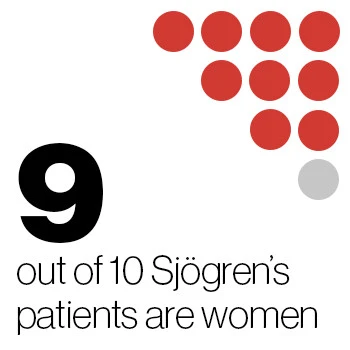Steven Taylor’s role as CEO of the Sjögren’s Syndrome Foundation is more than just a job; it’s a passion. Taylor has seen firsthand how Sjögren’s syndrome can impact people – his own mother has the disease – and this deeply personal connection is what drives him. Sjögren’s syndrome has no known cure and can manifest in various ways, often progressing to more serious symptoms that concern many patients. Taylor’s goal is to alleviate patients’ concerns and provide them with a sense of hope. “So many people live in trepidation of their disease progressing,” he says. “I really want to make a difference for patients and to provide them with a sense of hope now and for the future.”
I really want to make a difference for patients and to provide them with a sense of hope now and for the future.
Steven Taylor, CEO, Sjögren’s Syndrome Foundation
Fighting a common but little-known disease

Despite being one of the most common autoimmune diseases, Sjögren’s (“SHOW-grins”) syndrome is under-recognized by patients and even healthcare professionals. It is a systemic autoimmune disease that affects the entire body; many patients experience dry eyes, dry mouth, joint pain and fatigue. However, the disease can also cause other serious complications such as chronic pain, organ dysfunction, neuropathy and lymphoma. About half of the time Sjögren’s syndrome occurs alone, but it can also occur in conjunction with another autoimmune disease.1
Because this disease impacts patients in so many ways, Taylor and his team are working to educate different types of healthcare professionals – particularly rheumatologists, dentists and eye care experts – so that they can monitor possible symptoms and improve early diagnosis. This is one of Taylor’s greatest challenges.
Hearing patients express hope for new treatments is what motivates Taylor and his team to push forward and collaborate with companies like Novartis as well as healthcare professionals, researchers and patients themselves. As one patient put it: “I wake up each day hoping a treatment is developed that will allow me to live an active and normal life again.” Taylor wants new treatments to become available that not only address the symptoms of Sjögren’s syndrome, but also the underlying cause.
I wake up each day hoping a treatment is developed that will allow me to live an active and normal life again.
Sjögren’s syndrome patient
Shining a light on Sjögren’s syndrome
Two occasions each year further inspire Taylor to keep acting: Sjögren’s Awareness Month in April, and World Sjögren’s Day on July 23. Both provide opportunities for the foundation and similar organizations to increase awareness of Sjögren’s syndrome. They employ tactics like partnering with professional trade organizations to reach more healthcare professionals, and encouraging patients to share their experiences with family and friends. “If my work can bring a new treatment or even a cure closer, I know what that will mean for people living with this disease,” Taylor says.

To date, the Sjögren’s Syndrome Foundation has made significant strides in tackling this often-debilitating disease. In 2012, the foundation set a target to reduce the average amount of time it took to diagnose Sjögren’s syndrome (then six years) by half in the US. In 2016, the foundation announced it had met its target a year ahead of schedule. Now Taylor and his team are working to make additional progress and further reduce time to diagnosis before they reach their original deadline at the end of 2017. At the same time, they are spreading the word to healthcare professionals and patients alike that seemingly unrelated symptoms could in fact point to one disease: Sjögren’s syndrome.
1. Sjögren’s Syndrome Foundation https://www.sjogrens.org/home/about-sjogrens [last accessed: June 2017]
Learn how the Sjögren’s Syndrome Foundation is taking on an under-recognized autoimmune disease. #Sjögrens #ThisIsSjögrens
